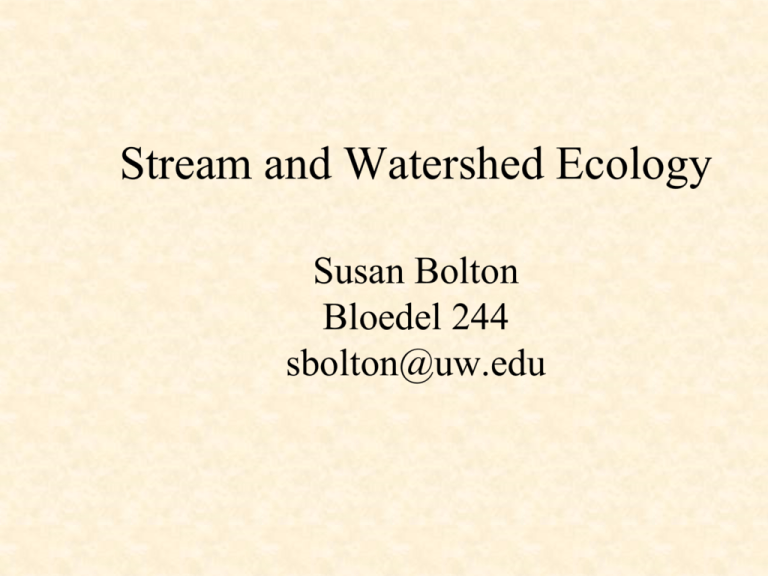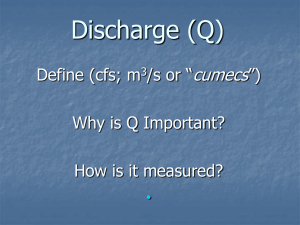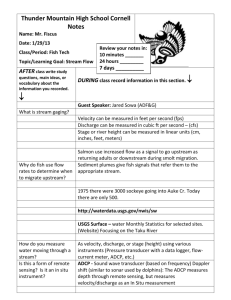Watershed assessment methods
advertisement

Stream and Watershed Ecology Susan Bolton Bloedel 244 sbolton@uw.edu Stream and Watershed Ecology • Ecology is the interaction of the biotic (living) environment and the abiotic (non-living) environment • In this module we will learn about important stream habitat-forming processes and how to do a quick assessment of these processes • More specifically students will learn: – what a watershed is, – who typically collects data, – what kinds of data are typically collected – how to collect and analyze some types of data – human effects on streams and hydrology Learning Objectives • What is a watershed? • Who measures water and watersheds? • What do they measure? • How do they measure and analyze it? • Human effects and management of watersheds What is a watershed? • The land area that drains into a selected stream point or water body • Can by very small or very large • Called catchments in the rest of the world • Usually based on surface topographysubsurface features may not mimic surface ones as far as drainage is concerned Graphic method of measuring area Count the vertices within the area • Each vertix represents the center of the area around it Scale 51 vertices Graphic method for area • Trace your watershed on vellum or other transparent paper • Lay the area over gridded graph paper • Count the number of vertices • Use the scale on your map to figure out how much area one square of your graph paper represents • Multiple the area of one square by the number of vertices you counted Other measurement methods • Can trace, cut and weigh your watershed • Can trace your watershed using a planimeter • Can use GIS or other electronic methods if you have the data layers • Can do a site survey with a level and rod or GPS Watershed areas • Area is a basic piece of information that one needs for many purposes, e.g., – – – – Trees /area Runoff / area Soil nutrients / area Watershed area defines the area that delivers water, sediment, organic matter and nutrients to a water body Who measures watersheds? Who measures water and watersheds? USGS- US Geological Survey USBoR – US Bureau of Reclamation USACOE – US Army Corp of Engineers USFS – US Forest Service NRCS – National Resources Conservation Service USEPA – US Environmental Protection Agency USFWS – US Fish and Wildlife Service NOAA – National Oceanic and Atmospheric Administration NMFS – National Marine Fisheries Service NWS- National Weather Service TRIBES Cities, counties, states, schools Watershed assessment methods • Many of the organizations we talked about the first week of class use some sort of watershed assessment technique to characterize landscapes – Each organization has slightly different procedures. – There are many examples on the web, e.g., any of the 62 Washington state WRIA (Water Resource Inventory Area) • http://www.ecy.wa.gov/services/gis/maps/wria/wria.htm – WA Dept of Natural Resources (DNR) • http://www.dnr.wa.gov/BusinessPermits/Topics/ForestPract icesHCP/Pages/fp_hcp.aspx Watershed assessment methods • Hydrologic regime – Analyze flow records for changes in peak flows (maximum), flow durations (how long a flow lasts), base flows (normal low flow), etc. – Compare flow records with precipitation data – Assess connectivity changes in watershed, e.g. dams, diversions, levees, impervious area Watershed assessment methods • Organic matter input processes – Assess riparian and floodplain forest/vegetation conditions – Identify current and historic fire return patterns PNW data source on fire history www.fs.fed.us/pnw/fera/research/climate/fire_history.shtml Watershed assessment methods • Nutrient input processes – Assess background inorganic inputs based on geologic and soils maps – Assess inputs from anthropogenic sources such as dryfall and wetfall deposition – Point and non-source inputs – Current or former seasonal inputs such as spawning fish and leaf fall Watershed assessment methods Sediment supply and erosional processes • Quantify landslides and estimate sediment budgets • Assign landslide hazard ratings to roads and hillslopes • • DNR http://www.dnr.wa.gov/BusinessPermits/Topics/Lan dslideHazardZonation/Pages/fp_lhz_review.aspx Seattle http://landslides.usgs.gov/regional/seattle/ • Map surface erosion areas such as unpaved roads, bare areas, construction zones Watershed assessment methods • Light and heat inputs – Assess current and historical shade/canopy conditions in stream and floodplain – Assess current and historic turbidity levels in streams What do we typically measure in streams and watersheds? General categories Land cover/land use, e.g. vegetation Physiography – soils, geology, topography Climate – precipitation, temperature, wind, humidity, streamflow, etc. Examples of more specific measurements related to stream ecology • • • • • • • • Precipitation Organic input to streams – LWD Nutrient input to streams Sediment input to streams Light and heat inputs to streams Biological communities in or adjacent to streams Streamflow – quantity, timing, duration and quality Channel characteristics – slope, bank full width, substrate, pools, riffles What do we want to know about precipitation? • • • • • Quantity (how much) Intensity (rate) (how much over how long) Temporal variation Spatial variation Form (solid, liquid) Precipitation gage What do we want to know about stream channels? • • • • • Slope Width Type Substrate Form Engineering view of a stream 1 5 V = 2 m/s A = 3 m2 n = 0.04 t = 120 N/m2 Ecological view of a stream B-IBI = 23 pH = 7.2 TDS = 110 mg/l DO = 8.3 mg/l D50 = 10 cm Adapted from Gordon et al. 1992 Slide by Jeff Grizzel Slide by Jeff Grizzel Water types in Washington • • • • S – shorelines F – Fish bearing Np – Non fish bearing but perennial flow Ns – Non fish bearing, only seasonal (intermittent) flow www.dnr.wa.gov/BusinessPermits/Topics/ForestPracticesApplications/ PermitPages/fp_watertyping.aspx Discharge Measurement Slide from U. Mass. Boston How do we measure how much water is in a stream? • Volumetric measurements– Works for very low flows, collect a known volume of water for a known period of time Volume/time is discharge = Q • Cross-section/velocity measurements • Dilution gaging with salt or dye • Artificial controls like weirs Velocity – Area Method of discharge measurement By measuring the cross-sectional area of the stream and the average stream velocity, you can compute discharge This is a continuity of mass equation Q = VA units are L3/t (volume / time) = discharge Where Q is discharge V is velocity A is wetted cross-sectional area and area = width x depth Photo from Black Hills State University Velocity – Area method of discharge measurement Tape measure- horizontal location of measures taken from tape Water surface Measurement represents mid-section of a polygon Velocity measured 0.6d from water surface (0.4d from bottom) Record x value (tape value), y value (water depth at measurement site, and velocity at 0.6d (you will have 3 values recorded at each spot) Mid-point method of calculating discharge (Q) Location of depth and velocity measurements Area included Area not included Key Assumption: Over estimation (area included) = Under estimation (area not included), therefore cross-section area is simply the sum of all the sections (rectangles), which is much easier than taking the integral! However, the hypotenuse of each over-under estimation triangle can be used to calculate the wetted perimeter. How many subsections? • Subsections should be at least 0.3 feet or ~0.1 m wide • Each subsection should have 10% or less of total discharge (i.e., if flow is deep and fast measurements should be closer together and if flow is shallow and slow they can be farther apart) • Number of subsections should be doable in a reasonable amount of time! Equation for computing subsection discharge - qi Equation for computing q in each subsection X = distance of each velocity point along tape Y = depth of flow where velocity is measured V = velocity Q = total discharge = sum of qis Float method of discharge measurement • Gives good estimates when no equipment is available • Use something that floats that you can retrieve or is biodegradable if you can’t retrieve it – E.g. oranges, dried orange peels, tennis balls, leaves, twigs Float Method surface velocity = distance / time average subsurfacevelocity = (0.8*surface velocity) Float method of velocity measurement Three people are needed to run the float test. One should be positioned upstream and the other downstream a known distance apart, one in the middle to record data. The upstream person releases the float and starts the clock and the downstream person catches the float and signals to stop the clock. The recorder writes down the time of travel of the float. Velocity is the distance traveled divided by the time it takes to travel that distance. Velocity = distance/time You should conduct at least 3 float tests and take an average velocity. This gives you surface velocity which is NOT the same as average subsurface velocity With an estimate of cross-sectional area, discharge can be computed as Q = VA where V is average subsurface velocity Channel Substrate • Substrate size (particles that line the channel) is an important component of habitat • Substrate size is important for fish habitat and macroinvertebrate habitat • Changes in land use/land cover can change substrate size distributions Substrate categories 1. 2. 3. 4. 5. 6. 7. 8. Sand, silt, clay. <0.25" or <0.8 cm (smaller than pea size) Gravel. 0.25" -1" or >0.8-2.5 cm (pea to golf-ball size) Large Gravel. >1" - 3" or >2.5-7.5 cm (golf-ball to baseball size) Small Cobble. [>3"-6" or >7.5-15 cm (baseball to cantaloupe size) Large Cobble. >6"-12" or >15-30 cm (cantaloupe to basketball size) Small Boulders. >12"-40" or >30cm-1.0 m (basketball to car-tire size) Large Boulders. >40" or >1.0 m (greater than car-tire size) Bedrock Substrate expectations • Pools usually have finer substrates – Velocity in pools is slower and finer particles settle out • Riffles usually have coarser substrates – Velocity in riffles is faster and finer particles are swept downstream Examples of organisms used as bioindicators Muskellunge Large mouth bass Stonefly Mayfly Caddis fly Midge Riffle beetle Photos from www.epa.gov/bioindicators/html/photos_fish.html and www.epa.gov/bioindicators/html/photos_invertebrates.html Aquatic Invertebrates • Stream invertebrates are frequently used as bioindicators • Benthic index of biotic indicator (B-IBI) uses numbers and species of aquatic invertebrates to assess stream condition What will we do in the field on Monday and Wednesday? • Go to a small stream at St. Edwards State Park: – Discuss low flow measurement issues – Assess light, sediment, water and nutrient inputs – Look for aquatic insects • Go to a larger stream (Juanita Creek) and take velocity cross-sections in order to compute total flow volume (discharge): using two different methods !!Please read the procedures before lab!! • Evaluate substrate, look for aquatic insects • Everyone needs to be dressed appropriately for the weather and for standing in water (we have some hip waders) • We will leave the C-10 parking lot at 12:30 sharp!





